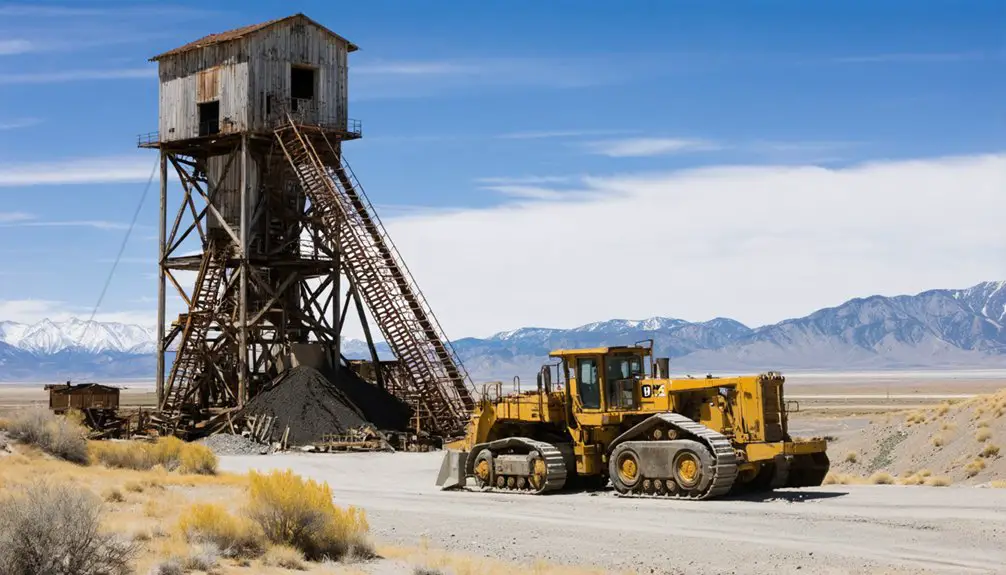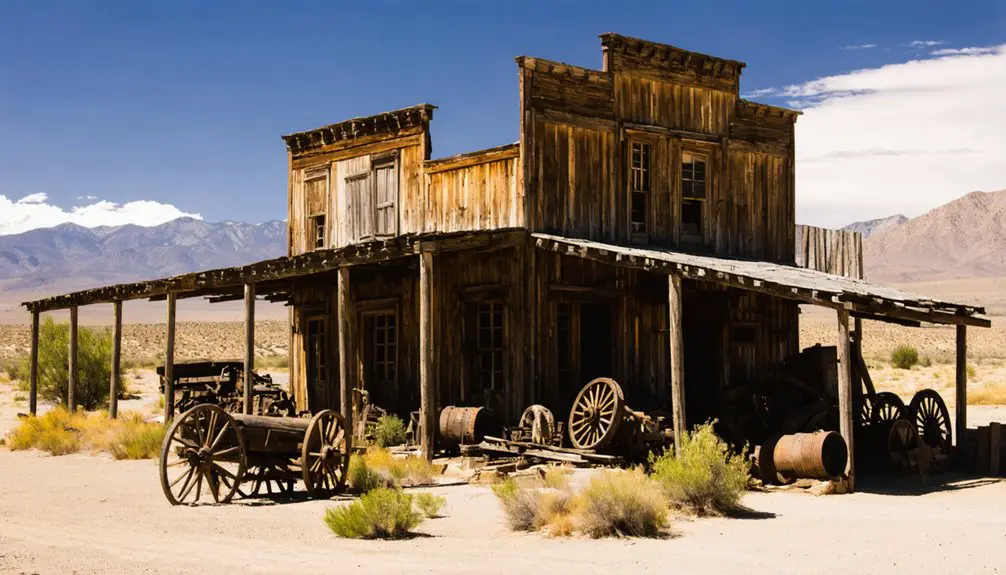You’ll find Cortez ghost town nestled in northeastern Nevada, where Mexican miners first discovered silver in 1862. Under Simeon Wenban’s leadership, the settlement grew to 400 residents by 1868, featuring stamp mills, leaching plants, and an essential water pipeline. The town’s preserved remnants include the Tenabo mill, historic tunnels, and original buildings that showcase late 19th-century frontier life. Mount Tenabo’s slopes hold countless stories of mining innovation, cultural significance, and unexplained phenomena.
Key Takeaways
- Cortez became a thriving silver boomtown in 1868 with nearly 400 residents, including American, Mexican, and Chinese laborers.
- The ghost town site contains several original buildings, including the prominent Tenabo mill remains above the settlement.
- Mining operations began in 1862 with silver discovery and peaked between 1864-1895, yielding $14 million despite economic challenges.
- The town featured essential infrastructure including stamp mills, leaching plants, and a water pipeline across Grass Valley.
- Historic structures showcase late 19th-century frontier architecture, with adobe buildings among the oldest surviving structures in the area.
The Discovery That Started It All
While Native Americans had long collected silver from the gullies near Mount Tenabo, the formal discovery of Cortez’s rich silver deposits occurred in 1862 when Mexican miners first identified the precious ore.
The initial silver discovery sparked further exploration when in spring 1863, a determined group of eight miners led by Simeon Wenban scaled the rocky face above these gullies to locate the valuable silver ledges.
Led by the ambitious Simeon Wenban, eight brave miners climbed treacherous terrain to uncover rich silver deposits in spring 1863.
You’ll find that this breakthrough prompted swift action in the region. The Cortez mining district was formally organized, and essential roads were constructed to connect the mining site with nearby settlements. The mining operations expanded rapidly, reaching a peak of 400 miners and woodcutters during the boom period.
These early mining techniques focused on extracting ore and transporting it to Austin for processing, laying the groundwork for what would become one of Nevada’s most significant mining districts. To avoid confusion with other mining settlements, the area was officially documented as a place name disambiguation in regional mining records.
Life in a Silver Boomtown
As Cortez developed into a thriving silver boomtown between 1868 and the 1890s, you’d find a diverse community of nearly 400 residents nestled against Mount Tenabo’s rugged slopes.
Community dynamics revolved around the bustling silver operations, where American, Mexican, and Chinese laborers worked the extensive tunnel networks, including the impressive 4,500-foot Garrison Mine. The mine reached depths of 1,270 feet underground.
You’d witness a town equipped with stamp mills, leaching plants, and a crucial water pipeline stretching across Grass Valley. In 1886, the town added a 50-ton lixiviation plant to process ore more efficiently.
Despite its remote location, Cortez maintained essential services like a post office.
Labor diversity shaped daily life, with mining companies preferring Chinese workers for their cost efficiency.
While living conditions remained rudimentary with wooden structures, the promise of silver – yielding about $300,000 annually during peak years – drew people to this isolated but opportune settlement.
Mining Operations Through the Ages
When Mexican prospectors discovered silver ore on Mount Tenabo in 1862, they launched a mining legacy that would span over 150 years.
You’ll find that early historical techniques included stamp mills and lixiviation plants, with Simeon Wenban’s eight-stamp mill expanding to meet growing demand. The economic impacts were significant, as the district generated over $300,000 annually from 1887 to 1891. Modern mining operations contribute substantially to the local economy, with local purchases exceeding $150 million annually.
The evolution of mining methods continued through the decades. You can trace the progression from early silver extraction to modern gold mining operations, where both open-pit and underground techniques now operate simultaneously. The introduction of heap leaching in 1969 revolutionized the district’s mining capabilities.
Mining at Mount Tenabo evolved from basic silver extraction to sophisticated modern operations combining both surface and underground methods.
The district weathered challenges, from the Tenabo Mill’s destruction by fire in 1915 to the quiet years of the 1930s-1950s. Today’s operations showcase advanced technology while building upon the foundation laid by those early prospectors.
Rise and Fall of a Mining Empire
Once Mexican miners discovered silver at Mount Tenabo in 1862, Cortez rapidly transformed from an unexplored wilderness into a thriving mining empire.
Under Simeon Wenban’s leadership, you’d have witnessed the district’s meteoric rise, with three companies operating by 1865 and the town’s population swelling to 400 by 1868. The district saw major technological advances when the Washoe Process mill was constructed in 1864.
The district’s peak years from 1864 to 1895 saw remarkable success, producing $14 million despite economic challenges. The mine’s location in Lander County, Nevada proved ideal for extensive mineral development.
Wenban’s innovative 50-ton mill and water pipeline system revolutionized operations, while labor dynamics evolved through the employment of Chinese and Mexican workers.
Though the original town declined after Wenban’s death in 1901, modern operations have proven even more lucrative, with over 1 million ounces of gold produced in 2003 and reserves exceeding 12.7 million ounces.
Legends and Lore of Mount Tenabo
You’ll find Mount Tenabo rising above Cortez as more than just a geological formation – it’s a sacred site within Newe Sogobia, the ancestral homeland of the Western Shoshone people.
The mountain’s springs host water spirits called Bah-o-hah, central figures in traditional healing ceremonies that have occurred here for generations. Historical records show the area experienced a gold rush in 1906 that brought dramatic changes to the landscape. The area’s natural resources have been exploited through cyanide heap-leach mining, causing significant environmental damage.
While gold mining operations have extracted billions in mineral wealth from the area, the mountain’s spiritual significance persists through both Native American oral traditions and documented archaeological evidence of ancient burials and ceremonial grounds.
Sacred Mountain History
Among the most sacred sites in Nevada stands Mount Tenabo, a mountain deeply woven into Western Shoshone creation stories and spiritual traditions. Its name, meaning “writing on the rock walls,” refers to the distinctive White Cliffs believed to bear the Creator’s marks.
This sacred significance encompasses the mountain’s role in preserving essential cultural heritage through:
- Traditional prayer and fasting ceremonies at sacred streams
- Collection of medicinal plants crucial for spiritual practices
- Hunting rituals passed down through generations
- Gathering of pine nuts from ancient pinion groves
You’ll find Mount Tenabo at the heart of Newe Sogobia, ancestral Western Shoshone land recognized in the 1863 Treaty of Ruby Valley but never legally surrendered.
Despite ongoing mining threats from operations like the Cortez Mine, the mountain remains a powerful symbol of indigenous spiritual resistance and cultural preservation.
Mining Spirits Live On
Throughout Mount Tenabo‘s storied mining history, tales of restless spirits and supernatural occurrences have permeated the mountain’s rugged terrain.
You’ll discover accounts of spectral miners, particularly from the late 19th century when dangerous working conditions and frequent fatalities plagued the operations. These ghostly encounters often trace back to Simeon Wenban’s era, when Chinese laborers endured harsh conditions in the mines and mills.
As you explore the abandoned mining sites today, you might sense echoes of the past in the weathered structures of the Tenabo Mill and along the defunct narrow-gauge railway lines.
The mountain’s legacy of mining-related violence, conflicts, and mysterious deaths has left an indelible mark, with witnesses reporting unexplained phenomena around the historic mining claims where countless workers once toiled beneath the earth.
Preserved Remnants of the Past
When you visit Cortez’s ghost town site today, you’ll find several original buildings still standing, though their deteriorating conditions tell of time’s steady march.
The extensive ruins showcase the town’s original layout, with the Tenabo mill remains perched above the settlement serving as a prominent landmark.
The site’s preserved mining tunnels, including the 1,270-foot-deep Garrison mine with its multiple levels, offer tangible connections to the area’s rich silver mining heritage.
Historic Buildings Stand Still
Standing as silent witnesses to Nevada’s mining legacy, the historic buildings of Cortez Ghost Town offer a compelling glimpse into late 19th-century frontier life.
The ghost town architecture showcases a diverse blend of construction methods, with adobe preservation efforts revealing one of the area’s oldest surviving structures.
You’ll discover these remnants of mining-era ingenuity across Mount Tenabo’s western slope:
- Weather-beaten adobe buildings displaying original construction techniques
- Wooden shacks and structures scattered throughout the hillside
- Stone foundations mixed with corroded metal supports
- Historical mills and cookhouses marking industrial zones
These architectural elements tell the story of Cortez’s evolution from an 1862 silver discovery through its peak production years, though harsh desert conditions continue to shape their weathered appearance.
Mining Equipment Tells Stories
As visitors explore Cortez Ghost Town‘s rugged terrain, preserved mining equipment reveals the technological evolution of Nevada’s mineral extraction industry.
You’ll discover remnants of pan amalgamation equipment from 1864, later replaced by advanced Russell leaching and cyanide processing machinery. The narrow-gauge railroad, with its 30-inch tracks and specialized ore cars, stands as a testament to innovative transport solutions.
At the Tenabo Mill site, you’ll find foundations and machinery bases that showcase the progression from simple ore processing to sophisticated flotation techniques.
The site’s artifacts, from hoisting buckets to blast holes, tell the story of mining machinery evolution. Each piece of equipment, whether preserved locomotives or abandoned leaching pads, offers glimpses into the ingenuity that drove Cortez’s mining operations for nearly a century.
Modern Gold Mining Legacy

The modern gold mining legacy of Cortez represents one of Nevada’s most productive mineral enterprises, yielding over 30 million ounces of gold since initial discoveries in 1966.
Cortez stands as a titan of Nevada mining, extracting more than 30 million ounces of precious gold since 1966.
As you explore this historic region, you’ll witness how gold mining has shaped both the landscape and economy through innovative extraction methods and environmental stewardship.
Key developments that transformed Cortez into a world-class mining district:
- Pipeline complex development in the 1990s, producing over 23 million ounces
- Cortez Hills’ integration of underground and open-pit mining with heap leaching
- $150 million annual local economic impact through operations and taxes
- Formation of Nevada Gold Mines LLC, uniting Barrick and Newmont’s interests
Today’s mining operations reflect a balance between resource extraction and environmental responsibility, demonstrating how modern technology can sustainably access deep mineral deposits while preserving surrounding landscapes.
Frequently Asked Questions
What Was the Average Wage for Chinese Miners in Cortez?
Like birds accepting smaller nests, you’d find Chinese miners earned up to $15 daily, though your research shows they typically received less due to discriminatory mining conditions compared to other workers.
How Many Deaths Occurred in the Cortez Mines During Peak Operations?
You can’t know the exact number of deaths during peak operations, though mine accidents occurred, including a 2022 fatality. Records of worker safety incidents remain incomplete across Cortez’s long mining history.
Were There Any Schools or Churches Established in Cortez?
Despite Cortez’s bustling mining operations, you won’t find evidence of formal schools or churches. Historical records don’t show any established institutions, though informal gatherings may have occurred among the transient population.
What Happened to Simeon Wenban’s Fortune After His Death?
You’ll find that Wenban’s fortune legacy continued through mining leases managed by his heirs for about 18 years after his 1901 death, with the estate maintaining control of valuable Cortez claims.
How Did Residents Get Their Food Supplies in Remote Cortez?
You’d get most supplies via stagecoach from Battle Mountain Station’s daily deliveries, while supplementing with local agriculture when possible. Food transportation relied heavily on wagon routes through Austin and nearby settlements.
References
- https://en.wikipedia.org/wiki/Cortez
- https://bonnevillemariner.wordpress.com/2007/04/26/my-first-ghost-town-trip-part-ii-cortez-nv/
- http://www.nv-landmarks.com/towns-c/cortez.htm
- https://forgottennevada.org/sites/cortez.html
- https://www.nvexpeditions.com/lander/cortez.php
- https://www.nevadaghosttownsandmininghistory.com/portfolio-2/cortez
- https://www.ghosttowns.com/states/nv/cortez.htm
- https://nevadamining.org/cortez-hills-the-story-of-nevadas-newest-large-scale-mine/
- https://www.pacificng.com/w/index.php?title=Cortez_Mining_Company
- https://westernmininghistory.com/mine-detail/10310410/



